Texts as Objects
In this page, the inscriptions of Shalamneser III are sorted
according to their material aspect. The following paragraphs present
short introductions, with links to the texts, for eight categories:
Salbs, Steles, Anthropomorphic statues, Rock faces, Monumental and
palatial inscriptions, Tablets, Clay cones, and Varia.
By clicking on "texts" a new tab with the relative
composite texts will be opened. By clicking on the texts'
numbers the user will be linked to their introductions in the portal pages
Slabs
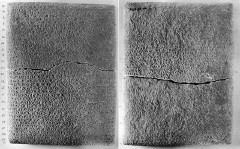
Texts [http://oracc.museum.upenn.edu/riao/Q004606,Q004608,Q004609,Q004616,Q004618/] nos. 1, 3, 4, 11, 13, 15 [this text is edited as text no. 14 "ex. 2." ], 1008 [too fragmentary to warrant an edition ]
Stone slabs bearing Shalmaneser's inscriptions have been found in different sites. Two at Nimrud, one inscribed with the earliest known version of the annals (text no. 1 [http://oracc.museum.upenn.edu/riao/theassyrianempire883745bc/shalmaneseriii/texts119/index.html#shalmaneser301], found in a storage room in Nimrud's Fort Shalmaneser), and one (no. 3 [http://oracc.museum.upenn.edu/riao/theassyrianempire883745bc/shalmaneseriii/texts119/index.html#shalmaneser303], found in Nimrud's temple of Nabû) which must have been the first of a series of slabs bearing a version of the ruler's annals (this text has many similarities with the text no. 2 Kurkh Monolilth; see, "Stele"). At Til Barsip (Tell Ahmar) was found one large slab (no. 4 [http://oracc.museum.upenn.edu/riao/theassyrianempire883745bc/shalmaneseriii/texts119/index.html#shalmaneser304], 177x98 cm) bearing an unfinished inscription (also with many similarities with text no. 2). Three slabs come from Ashur: one (no. 11 [http://oracc.museum.upenn.edu/riao/theassyrianempire883745bc/shalmaneseriii/texts119/index.html#shalmaneser311], present location unknown) has many similarities with text no. 10 (see, "Tablets"); a fragmentary text (no. 13 [http://oracc.museum.upenn.edu/riao/theassyrianempire883745bc/shalmaneseriii/texts119/index.html#shalmaneser313], present location unknown) was probably written to commemorate the works on the Aššur temple and has portions of accounts of military campaigns from the fifteenth to twenty-first regnal years (844-838 BC); numerous fragments of a large stone slab (no. 15 [http://oracc.museum.upenn.edu/riao/theassyrianempire883745bc/shalmaneseriii/texts119/index.html#shalmaneser315], one large piece was found in the temple area) bear, when put together, a text that "duplicates" lines 1-47 of text no. 14, the Black Obelisk (and therefore catalogued by Grayson as an exemplar of this text) but ends abruptly, suggesting that also this inscription, like text no. 3, was the first of a series on which the annals of the ruler were recorded. In Nineveh, was found a very small fragment of a stone slab (text no. 1008) [http://oracc.museum.upenn.edu/riao/theassyrianempire883745bc/shalmaneseriii/texts10012003/index.html#shalmaneser31008], of which one line has been compared by Borger to one on text no. 2, and therefore temporary attributed to Shalmaneser.
Stele
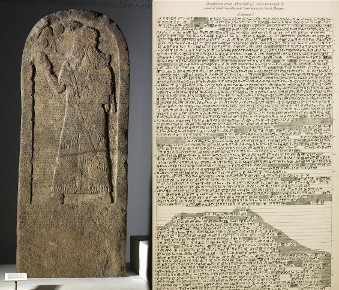
Texts [http://oracc.museum.upenn.edu/riao/Q004607,Q004614,Q004736/] nos. 2, 9, 2002
Three stelae of the time of Shalmaneser have been found. A large
stone stela (the so-called "Kurkh Monolith," text no. 2 [http://oracc.museum.upenn.edu/riao/theassyrianempire883745bc/shalmaneseriii/texts119/index.html#shalmaneser302], 220 cm high)
of the king of the kind called ṣalam šarrūtiya "image of my
royalty" has been discovered together with a similar one belonging to
Shalmaneser's father Ashurnaṣirpal II's (see this ruler's text
no. 19) in the city of Kurkh (Üçtepe) in the Turkish province of Dyarbakir. It bears an early version of the annals, which ends abruptly after the record of the well known battle of Qarqar (853 BC), and crosses (on the front side of the monument) the image carved in relief of the ruler. Of possibly similar nature is a stela (no. 9 [http://oracc.museum.upenn.edu/riao/theassyrianempire883745bc/shalmaneseriii/texts119/index.html#shalmaneser309]) of which remains only a fragment, now stored in the Walters Art Gallery of Baltimore and said to come from Ashur.
A very different kind of stela (no. 2002 [http://oracc.museum.upenn.edu/riao/theassyrianempire883745bc/shalmaneseriii/texts10012003/index.html#shalmaneser32002]) from the same period belongs not to
Shalmaneser himself, but to his turtānu Bēl-lūballi (see also text no. 2001 [http://oracc.museum.upenn.edu/riao/theassyrianempire883745bc/shalmaneseriii/texts10012003/index.html#shalmaneser32001]) and was found among the row of stelae at Ashur dedicated, since the Middle-Assyrian period, to high dignitaries.
Anthropomorphic statues
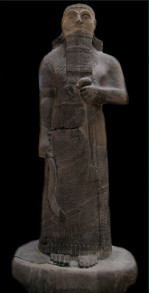
Texts [http://oracc.museum.upenn.edu/riao/Q004617,Q004621,Q004630,Q004643,Q004645/] nos. 12, 16, 25, 38, 40
Five statues in the round depicting Shalmaneser III have been
retrieved from the cities of Nimrud, Ashur and Nineveh. A statue (text no. 12 [http://oracc.museum.upenn.edu/riao/theassyrianempire883745bc/shalmaneseriii/texts119/index.html#shalmaneser312]) dedicated to the god Adad of Kurbail (north of Nineveh, possibly in the Kurdish region of Dohuk) was found in Nimrud, at Fort Shalmaneser, where it had been stored in order to be repaired. Also from Nimrud, but from the outer town, come numerous fragments of a white limestone statue (no. 16 [http://oracc.museum.upenn.edu/riao/theassyrianempire883745bc/shalmaneseriii/texts119/index.html#shalmaneser316]), that, once reconstructed, shows to represent the king dressed in full canonicals for his office as High Priest of the god Ninurta; the statue has a very similar narrative to that of text no. 14 ("Black Obelisk;" but see also "Tablets," texts nos. 6 and 10).
From Ashur come two statues, whose exact original location is unknown, but that in both cases can reasonably guessed to be the Tabira Gate. A statue of a seated Shalmaneser (no. 25 [http://oracc.museum.upenn.edu/riao/theassyrianempire883745bc/shalmaneseriii/texts2039/index.html#shalmaneser325]), visibly damaged, is inscribed on the sides and the back of the throne mentions the Gate. The second statue (no. 40 [http://oracc.museum.upenn.edu/riao/theassyrianempire883745bc/shalmaneseriii/texts4062/index.html#shalmaneser340]) was found broken in pieces at the entrance to a Parthian building at Ashur, and is now stored (reconstructed) in the Archaeological Museum of Istanbul. Also in this case the inscription mentions the Tabira Gate, but also the restoration of the inner and outer walls of Ashur, and a non-chronological record of several military campaigns of the ruler.
Two stones from a statue (no. 38 [http://oracc.museum.upenn.edu/riao/theassyrianempire883745bc/shalmaneseriii/texts2039/index.html#shalmaneser338]) found at Nineveh reveal, although badly damaged, an inscription from the reign of Shalmaneser III, including a (very fragmentary) dedication to Ištar, and a brief and non-chronological description of some of his conquests.
Rock faces
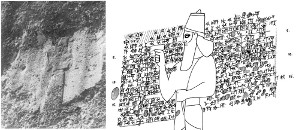
Texts [http://oracc.museum.upenn.edu/riao/Q004625,Q004626,Q004627,Q004628,Q004629/] nos. 20-24.
Rock faces belonging to Shalmaneser III have been found in two placxes. Near the Kenk Boğazı/Kenk Gorge, along the Upper Euphrates, a rock face (text no. 20) with a portrait of the king is carved in relief and an inscription engraved on both sides is found.
Four texts belong to the same group of inscriptions that were engraved with a portrait of the king on rock faces at the sources of the Tigris, where the river Sebeneh-Su goes through a tunnel. Texts nos. 21-22 are the earliest in date and describe the "third campaign" to Nairi in 852 BC (seventh palû), whereas nos. 23-24 record the events as far as 850 (ninth palû) and 845 (fourteenth palû). A depiction and description of the craving of the reliefs and the inscriptions is most probably the one given also in one of the scenes and epigraphs of Shalmaneser's Balawat Gates (nos. 77-78 = L6).
An inscription of Tiglath-pileser I (this ruler's text no. 15) is also present on the same rock face, also accompained by a portrait of the ruler.
Monumental and palatial inscriptions
The major building projects carried by Shalmaneser III were in Ashur and Nimrud, but it is in the latter that the majority of monumental inscriptions were found, especially in the area of so-called Fort Shalmaneser, the ēkal mašarti ("Review Palace") that he founded inside the city walls perimeter.
Texts [http://oracc.museum.upenn.edu/riao/Q004610,Q004619,Q004633,Q004634,Q004635,Q004636,Q00463,Q004638,Q004639,Q004640,Q004641,Q004642,Q004655,Q004656,Q004658,Q004660,Q004661,Q004662,Q004663,Q004664,Q004665,Q004666,Q004667,Q004668,Q004669,Q004670,Q004671,Q004672,Q004673,Q004674,Q004675,Q004676,Q004677,Q004678,Q004679,Q004680,Q004681,Q004682,Q004683,Q004684,Q004685,Q004686,Q004687,Q004688,Q004689,Q004690,Q004691,Q004692,Q004693,Q004694,Q004695,Q004696,Q004704,Q004705,Q004706,Q004707,Q004708,Q004709,Q004710,Q004711,Q004712,Q004713,Q004714,Q004716,Q004719/] nos. 5 [Balawat gates], 14 [Black Obelisk], 28 [Throne base], 29 [Throne base], 30-37 [Door sills and Door bolt sockets], 50, 51, 53, 55, 56, 58 [Bricks], 57, 59-62 [Throne base], 63-86 [ Balawat gates], 87-91 [Black Obelisk], 99-109 [Bricks], 112 and 114 [Glazed brick panels].
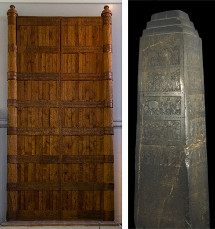
In the city of Igmur-Enlil/Balawat, the ruler realized, just like his father before him the monumental Gates, which have two main inscriptions, one (in two copies) on the edge of the gate leaves (text no. 5), and the epigraphs on the door bands (nos. 63-86).
From the city of Kalhu/Nimrud comes the very well preserved "Balck Oeblisk," which has also two sets of inscriptions, a main one (no. 14), engraved on the top and botom parts of the monument, and the epigraphs associated to the five rows of images carved in relief, depicting the king's exploits in different Mesopotamian regions. (nos. 87-91).
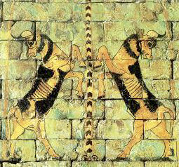
Shalmaneser founded in Nimrud his Review Palace, or Fort Shalmaneser, where many inscriptions of his were found still in situ by the excavators. These are: two throne basis, one (no. 28 and 57, 59-62) from the main throne room (T1), inscribed on all its surfaces, including under the eastern block, alone or alongside the reliefs that are carved on the front side of the west block, and one (no. 29) discovered in secondary position in the south eastern courtyard of the fort (possibly for the purpose of reviewing the army there); a series of door sills and bolt sockets that adorned the whole throne quarter (T); two panels (both under no. 114) of glazed bricks. The fragments of a further panel of glazed bricks were found also in the acropolis of the city, in the South-East Palace (Assyrian building AB; no. 112).
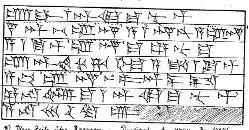
Examples of bricks from the reign of Shalmaneser III have been found in different cities.
From Ashur various brick inscriptions record the works on different parts of the city, like the temple of Šarrat-nipḫi (nos. 50-51), the temple of Aššur (nos. 53, 103), the wall of Ashur's Inner City (nos. 99-100), the Tabira Gate (no. 101).
Numerous bricks from Nimrud bear an inscriptions (no. 56) recording Shalmaneser's construction of the city's ziggurat. Two inscribed bricks (no. 55) record the making of the god Armada's gold statue, presumably the patron deity of the city Arwad. Inscriptions defying the bricks as part of the facing of palaces are from Ashur (no. 102, facing of the Anu-Adad temple) and from Nimrud (111, facing of the ziggurat). A fragmentary text (no. 58) from Shibaniba (Tell Billa), mentions the goddess Ištar.
Bricks with simple É.GAL inscriptions ("Palace of...") have been retrieved at Šibaniba (no. 104), Ashur (no. 106), Nineveh (no. 104), Ashur (no. 109), and at an unknown place (no. 105).
Some bricks from Ashur are engraved with a text (no. 108) that has been ascribed also to Shalmaneser II (see RIMA 2 p. 124); an hypothesis that Grayson finds unlikely preferring the present attribution.
Tablets
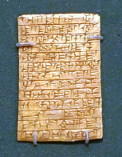
Texts [http://oracc.museum.upenn.edu/riao/Q004611,Q004615,Q004622,Q004631,Q004722,Q004723,/] nos. 6, 7 [edited as text no. 6's "ex. 11"], 10, 17, 26, 1001, 1002, 1010 [too fragmentary to warrant an edition].
Inscriptions of Shalmaneser III on tablets of clay, stone and gold have been found in different locations. Three tablets come from Ashur: text no. 6 is a version of Shalmaneser's annals that was found on several exemplars on clay tablets. All the retrieved exemplars come from Ashur, except ex. 11, found at Nimrud, which is in fact text no. 7, a shorter version of the annals); the only complete inscription, exemplar one, was retrieved in the outer wall of Ashur together with a stone tablet, text no. 10, which consists in a long version of the annals completed by a building section dedicated to the works on the fortification walls of the New City in Ashur; also presumably from the walls of the city Ashur is text no. 26, a small golden tablet (2.9x4.1 cm), possibly originally deposited in an alabaster box similar to the one listed here as text no. 27.
From the site of Sultantepe, ancient Ḫuzirina, comes the unusual text no. 17 is characterized by the structure of a royal inscription, but written in poetic language with extensive use of direct speech, although without following the typical characteristics of epics.
Two uncertain fragments on clay tablets seem to be parts of Shalmaneser's annals. While text no. 1001 is of unknown provenance, no. 1002 comes from Nimrud.
Finally, no. 1010 is but a flake of clay surface found at Nineveh is not enough preserved to warrant an edition, but which seems to concern Shalmaneser III (although it is not necessarily a royal inscription).
Clay cones
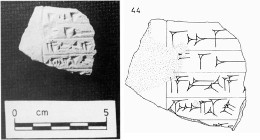
Inscribed clay cones with different inscriptions come from Ashur and Tell al Hawa
The largest portion of inscribed clay cones from Ashur belong to the reign of Shalmaneser III and bear various types of inscriptions that can be divided according to the building enterprises they record. Dnbaz and Grayson (RICCA) have identified five types (A-F), Types A-C record the works on the walls and gates of Ashur in years 836 BC (type C, no. 44 and 45), 834 (type B, no. 43) and 833 (type A, no. 42); type D concerns the reconstruction of the Anu-Adad temple in 839 (no. 39); type E deals with the works on the Aššur temple in 849 (no. 18); type F records the works o the Tabira Gate in 842 (no. 46)
A different clay cone inscription from Ashur is no. 52, which concerns the works on the Šarrat-nipḫi temple, which makes it close to the very similar inscriptions nos. 50-51 found on bricks from the same city.
At Tell al-Hawa, a large mound northwest of Nineveh, numerous clay cones have been found bearing the same text (no. 41) commemorating the work at this city on the Adad temple. Nos. 1005-1006 are fragments that could be part of the same group of texts.
Varia

Short inscriptions have been found in various kinds of objects, in different places. A large stone block (no. 49) found in the vicinity of the Ištar temple at Ashur records the rebuilding of the Širrat-nipḫi (see bricks inscriptions nos. 50-51 and the cone no. 52). A stone altar (no. 95) found in the plain of Nineveh is inscribed with a dedicatory inscription to the gods Sibitti and has two Greek inscriptions added later. A stone vessel (no. 2001) was discovered at Tarbiṣu, inscribed with a dedication to Nergal, the city's patron diety, given by the Assyrian turtānu Bēl-lūballiṭ (eponym in 814 BC).
Stone maces with dedicatory inscriptions were found at Ashur (no. 94) ,
Tarbiṣu (no. 96) and an unknown place (no. 97, possibly also Tarbiṣu). A fragment of a stone amulet (no. 19) was presumably displayed in the Ninurta temple of Nimrud, judging from its initial dedication. A dark green (onyx) "eye-stone" (no. 1003) of unknown provenance bears a dedication to a deity called Ḫallasua otherwise unattested. A bead (no. 92) of black stone with white veins and bored through the centre, was discovered at Ashur and has an inscription that identifies it as part of the booty from the city of Malaḫa, which was part of the territory under the control of Hazael of Damascus. A small dark-green gem (no. 1004) of unknown provenance is inscribed with a text, which could of course belong to Shalmaneser I as well. A stone box (no. 27) was found at Ashur and presumably contained some inscribed tablets, and perhaps the golden tablet text no. 26 was one of them.
A fragmentary text is inscribed on a small piece of polished red stone
of concave shape that might have been part of a bowl or of a
spoon (no. 113) was
found at Fort Shalmaneser. Two inscribed plates of lead were found at
Ashur (no. 110). A
palace label of Shalmaneser, with name and titles of the king, was
found on a broken stone lion-weight (no. 115) in room SE 11 (possibly a
kitchen) of Fort Shalmaneser. A clay cube (no. 2003) of unknown provenance was,
as the inscription on it indicates, a die for casting lots for an
eponym.
Nathan Morello
Nathan Morello, 'Texts as Objects', The Royal Inscriptions of Assyria online (RIAo) Project, The RIAo Project, a sub-project of MOCCI, 2020 [http://oracc.museum.upenn.edu/riao/theassyrianempire883745bc/shalmaneseriii/textsasobjects/]